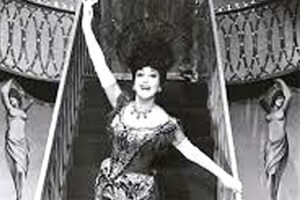In 1968, I toured with the Dorothy Lamour national company of Hello, Dolly! to more than 90 cities. Miss Lamour had taken over the tour from Carol Channing. In fact, she learned the role directly from Channing. She gave a quite stunning performance, and unsurprisingly her singing was excellent, given that she had been a major big-band vocalist before her movie career. Dorothy was a tough cookie and was very proud of the work she was doing in the show. When we played Dayton, Ohio, the local critic savaged her cruelly and unfairly, complaining that he could see the bags under her eyes from the back row. The next night in her curtain speech she angrily said, “I just want a certain critic to know that I have had these bags under my eyes since I was twelve years old.”

The following tale is excerpted from my autobiography, The Wrong Side of the Room: A Life in Music Theater.
Dorothy’s son was in the Marines, and she made a special point of it during her curtain speech each night, perhaps to counter all the antiwar demonstrations sweeping the country. During World War II, she had raised a fortune for war bonds and often entertained soldiers at the Hollywood Canteen. It seemed appropriate then that she requested that we perform for the troops at Ft. Leonard Wood, Missouri. We played in a large hall that bore no resemblance to a theater. It was impossible to use any sets, only the furniture and props. There was, in fact, no stage, but rather large pieces of board set up on sawhorses. One could quite literally apply that old showbiz saying, “treading the boards,” in this case. Our stage crew was ingenious at adapting the show to any environment. There was no air conditioning and the space was stifling. Dorothy used her usual device to remain cool and diminish sweating, a small ice pack on her wrists.

During the first act, we gave it everything we had, but there was virtually no reaction from the soldiers in the audience—no laughs and very little applause. The commander came backstage to speak to Dorothy during intermission. “What’s going on out there?” she asked him in a very upset state. “Do they hate the show that much?” The commander said, “Oh, not at all, Miss Lamour. They were all warned that they had to behave themselves, remain quiet, and act respectfully to the performers.”
“Well, you go out there and tell them to loosen up, have a good time, and enjoy themselves, because we’re dying up here.”

Never has an audience changed so radically mid-performance. During the second act, they began shouting, laughing, and applauding riotously at everything we did. The jumps at the end of “The Waiters’ Gallop” provided unheard of thrills. I was the first dancer to begin the jumps at the end of the number. I noticed at my first jump that I rose higher than I thought possible, and with each successive jump and each dancer joining me, we soared higher and higher. This was because the boards resting on sawhorses were acting as a sort of trampoline. The orchestra had to adjust the tempo constantly because there was no consistency in the length of time between jumps. We were literally flying by the end of the number.

The experience turned out to be one of the more satisfying performances on the tour. Often, we found that when we were constrained in our use of sets and paraphernalia, we got the most enthusiastic audience reception.

The “Waiters’ Gallup.” The author at far left.


